Menu

Did you know that by 2050, the world’s population will reach 9.7 billion? This will increase our need for food by 70%. To meet this demand, we need to boost crop yields and change how we do farming. A big part of this change should focus on making soil healthier. This helps our planet, supports sustainable farming, and fights the problems of intensive agriculture.
Using a lot of land for crops and relying too much on chemicals has harmed our soil. It has also led to pollution and used up a lot of natural resources. Moving towards more sustainable ways of farming is crucial for our Earth’s future. This change will lower the harm to our environment. Plus, it will make our food cleaner and healthier.
The soil microbiome is a community of tiny organisms. It was first named by Lederberg and McCray. They include helpers, partners and some harmful germs. Knowing about these tiny life forms helps us farm in a way that keeps the Earth healthy.
This world within soil is full of bacteria, fungi, archaea and viruses. A big discovery found that 70% of soil bacteria are top species. These tiny beings keep everything in balance. They help plants grow, recycle nutrients and keep the soil healthy.
Soil microbes are very important. They work as guards, helpers and food providers for plants. This makes crops stronger without needing extra help. A healthy mix of these tiny creatures makes the soil, plants, animals and people well.
The variety of these tiny life forms is key for the soil and the world they support. They do over 40 jobs that keep everything healthy. By making plants grow better, they help the whole ecosystem. Even the bacteria on seeds help new plants grow strong.
Soil bacteria are key players in the soil’s small world, supporting soil health and plant growth. Knowing about the many types of soil bacteria helps us use them better. This can boost farming’s effectiveness and help ecosystems thrive.
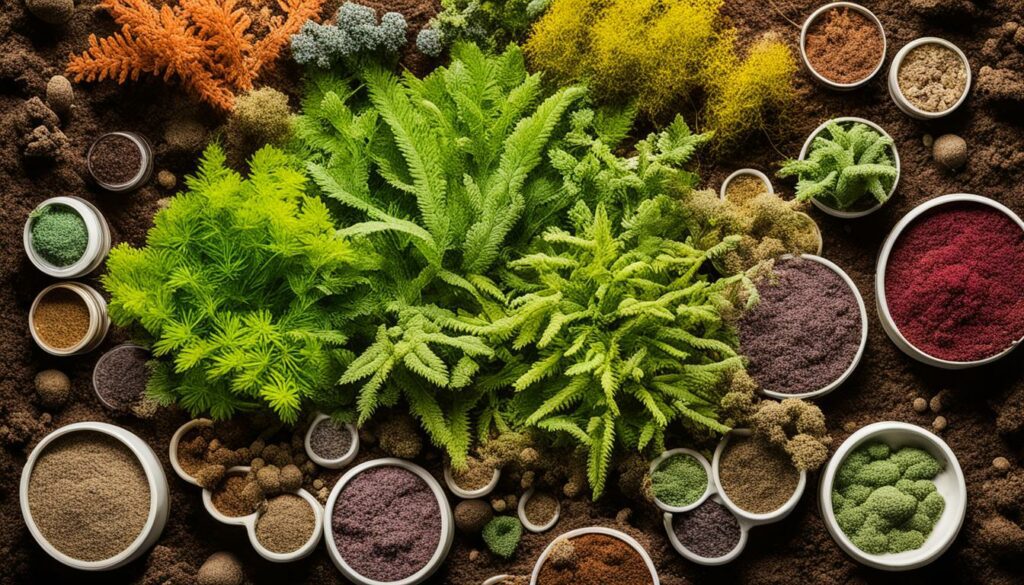
The soil microbiome includes several important bacterial groups. Proteobacteria, Actinobacteria, and Firmicutes are major players. They help recycle nutrients and fight off harmful organisms. For example, Rhizobia and Frankia aid in nitrogen fixation, giving plants vital nutrients. A variety of bacteria is necessary for healthy soil and crops, supporting eco-friendly farming.
Soil bacteria do a lot of important work. They break down dead plants and animals, turning them into nutrients plants can use. Bacteria like Pseudomonas and Bacillus unlock key minerals like phosphorus and potassium, helping plants grow strong. They also change the nitrogen in the air into a plant-friendly form. This is crucial for plant growth.
Moreover, some bacteria protect plants by keeping harmful germs in check. They either compete for space with the bad bugs or directly fight them off. By increasing the range of bacteria in the soil, farms can become more resistant and fruitful. This all helps ecosystems keep providing their many benefits.
Notably, some key studies have shown that looking after our soil is essential for the future. By taking care of soil’s health, we ensure farms can keep producing food. And soil bacteria are a big part of this success story.
The soil fungal community is key in keeping soil healthy and helping plants grow. Fungi break down organic matter and cycle nutrients. They form partnerships with plants, helping with water and nutrient uptake.
Good fungi turn organic matter into plant nutrients and cycle nutrients. They can stop diseases by fighting off harmful fungi. Fungi like arbuscular mycorrhizal help plants take in nutrients and survive tough times.
Bad fungi can lead to plant diseases. But, a study in the Philippines showed something interesting. Plantations with less disease had more helpful bacteria and microbes. These friends of the soil made the plants better at fighting stress.
Farmers can do a lot to help fungi thrive. They can:
Less chemical fertiliser combined with organic help can make soils better. It also grows more crops. Fertilisation can change the type of fungi in the soil. It boosts good fungi while reducing the bad kind around cassava plants.
So, it’s important to know and improve the soil fungal community for lasting farming. With the right steps, we can have soils that grow strong, healthy plants.
Microbial interactions in soil are key for the environment and help nutrients flow for strong plant growth. In the Gansu Qilianshan National Reserve, a place at high altitude in China, a study focused on these links. This region has a cold, dry climate with frost almost year-round.
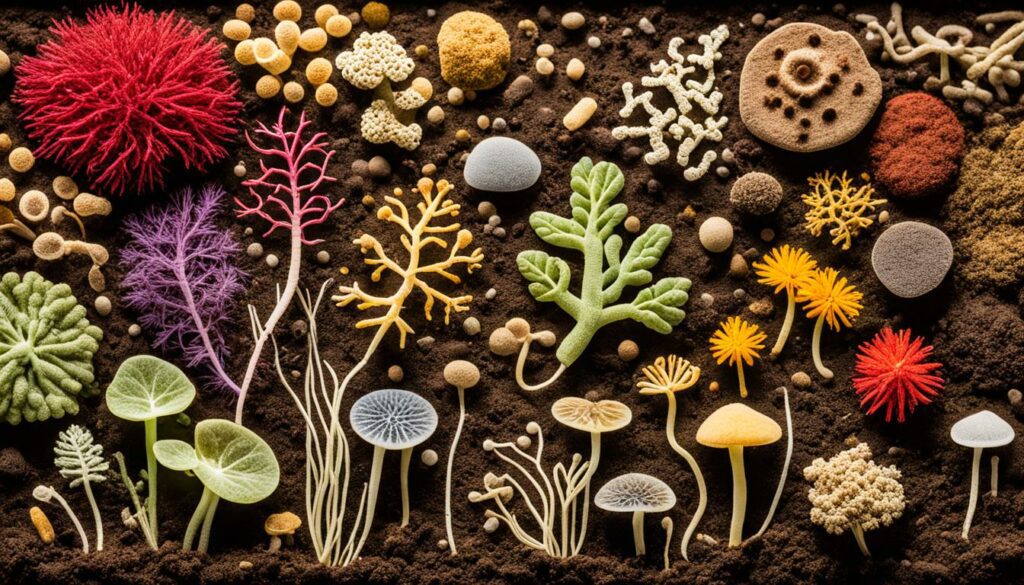
The study looked at main plants like Rhododendron simsii, Dasiphora fruticosa, and Salix oritrepha. Scientists placed small plots near these shrubs to see how soil microbes worked. This method helped them study a wide range of soil microbes.
They picked 10 people, sorry plants, from each kind to study. They took soil samples around them, mixing and dividing them for tests. This detailed process taught them a lot about how microbes work, helping in biofortification.
Biofortification means making food crops more nutritious to fight against malnutrition. By using the help of soil microbes, plants can take in more nutrients. This makes farming better for the long run, reducing chemical use and improving soil.
The study in the Gansu Qilianshan area pointed out how important understanding soil microbes is. Using this knowledge wisely in farming improves the environment, supports making food more nutritious, and helps the Earth. It can play a big role in achieving food security and helping the planet.
Understanding soil microbial ecology is key to grasping the intricate links in soil. These links affect ecological interactions and greatly influence soil health.
In soil, ecological interactions are vital for keeping the soil healthy. Soil microbiomes serve as biocontrol agents and biostimulants, helping plants grow. They also act as biofertilisers, making food crops richer in micronutrients, which fights malnutrition.
About crop rotation, it boosts the variety of soil microbes. This helps with nutrient recycling and keeps pests in check.
It’s crucial to know how these interactions affect soil health. Using sustainable farming methods protects resources, cuts pollution, and keeps soil alive and fertile. Soil microbes are key in processes like nitrogen fixing and phosphorus movement.
They boost crop yields and lower harmful pathogens. The link between soil microbial ecology and soil health stresses how a balanced ecosystem is vital for lasting farm success and health.
A single gram of soil can have billions of bacterial cells and tens of thousands of species. This shows the vast variety and numbers of soil bacteria.
| Role of Soil Microbiomes | Functions |
|---|---|
| Biocontrol Agents | Suppress plant pathogens |
| Biostimulants | Enhance plant growth |
| Biofertilisers | Improve nutrient uptake |
| Probiotics in Functional Foods | Promote human health |
The makeup of soil’s tiny life forms is key for our ecosystems to work well. It’s very important to know how soil life helps plants grow strong. By recycling important nutrients like nitrogen, plants can do more than just live. They thrive. So, having the right mix of soil life is vital for farming that doesn’t harm the earth.
“A study in 2018 identified a global atlas showcasing the dominant bacteria found in soil, highlighting the diversity and distribution of soil microbiota.”
It’s also key to see how the soil’s small residents help fight off bad bugs and tough weather. Different groups of these tiny beings help plants stay healthy and stand up to hard times. This keeps our natural world balanced and well.

Many research papers tell us why having a lot of different microbes in soil is good. For example, a study in 2017 showed us how these tiny worlds differ in various places. This helps us learn how to take better care of our soils by keeping the life in it diverse.
Taking care of soil life means we must watch how we treat the earth. A study in 2018 showed that what we do every day can change the types of tiny life forms in the earth. So, we must be careful and use ways that keep the soil and everything living in it healthy.
| Year | Study Focus | Key Findings |
|---|---|---|
| 2018 | Global Atlas of Soil Bacteria | Showcased diversity and distribution of soil microbiota |
| 2017 | Earth’s Microbial Diversity | Emphasised abundance and variety of soil microorganisms |
| 2017 | Soil Microbiome Dynamics | Compared microbial diversity in different soil samples |
| 2011 | Microbial Community Diversity | Demonstrated diversity generation and maintenance in soil ecosystems |
| 2015 | Microbial Community Ecology | Presented practical significance of diverse microbial populations |
Looking after and understanding soil life sets a strong base for better soil and ecosystems. This knowledge is critical for short-term farming success and the long life of our planet.
Helping soil thrive is crucial for good farming and a healthy earth. We can make soil full of life by adding natural stuff, using different ways to grow plants, and not messing it up too much.
Adding natural stuff like compost can really improve the soil’s tiny life. Compost has lots of good nutrients for plants. It also has helpful plant germs that don’t come in artificial versions.
Worm poo is also great for the soil because it’s full of important nutrients. You can make your own by keeping red wiggler worms. With this, you always have a fresh supply of enriching compost.
There are other easy ways to boost good germs in the soil, like using molasses and ground. These methods are simple but powerful.
Changing how we grow crops helps keep the soil full of different tiny beings. Mixing up what we grow in a field and adding plants together can do wonders. This mix supports a variety of these microorganisms.
It helps the soil and the plants fight off bugs and diseases too. Adding a special fungus, Rhizophagus irregularis, can make plants’ roots stronger. This way, they can get more nutrients from the soil.
Being gentle with the soil keeps its hidden life healthy. Turning soil over too much and using too many chemical fertilisers is bad for these tiny worlds. They mess up the balance of nutrients.
Instead, we can use a special kind of fertiliser. It helps the soil’s little creatures without hurting the environment. This method boosts the life and health of the soil, helping it grow plants better on its own.
Following these key strategies carefully can make the soil team with life. This is vital for strong and lasting farming for the next generations.
| Strategy | Benefits |
|---|---|
| Using Organic Amendments |
|
| Cropping Practices |
|
| Minimising Soil Disturbance |
|
A lively soil microbiome helps create balance in nature and boosts sustainable farming. It shows us how soil microbes and plant health work together. This relationship brings many good things to our world.
A healthy soil microbiome helps plants grow better. Microbes in and around plant roots team up to help plants get more nutrients. This helps the plants grow strong. For example, plants like chickpeas and white lupines work with certain microbes to absorb more phosphorus. This shows how they help each other grow.
Soil microbes play a big part in moving nutrients around. They break down dead plants and animals, turning them into nutrients for living plants. This helps keep the soil rich and fertile. Good farming methods, like changing the crops you grow in a field every year, are important. They help keep this nutrient cycle working well and the soil healthy.
A healthy soil microbiome can fight off harmful germs. Many different microorganisms live in the soil. They can stop disease-causing germs from growing well. This means farmers might not have to use as many chemicals. With fewer chemicals, farming is safer for people and the planet.
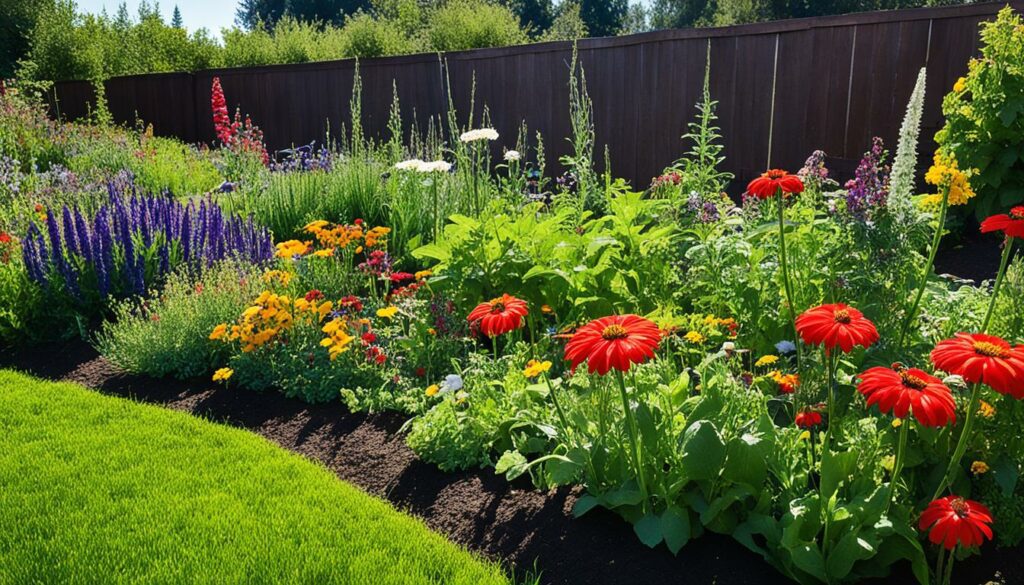
“The environment plays a dominant role over host genetics in shaping human gut microbiota.” – Findings revealed in 2018
Healthy soil microbes are a real asset for farming. They help farms produce more food in a sustainable way. They also keep the environment healthy. By supporting the flow of nutrients and fighting off germs, soil microbiomes have a key role in making our food system better.
| Benefit | Impact |
|---|---|
| Improved Plant Growth | Enhanced nutrient uptake and robust plant development |
| Enhanced Nutrient Cycling | Maintains soil fertility and ensures nutrient availability |
| Reduction in Pathogens | Minimises disease occurrence and reduces dependency on chemical pesticides |
We need to know about role of biofertilisers in keeping soil healthy. This is vital now as we face a future with more people to feed. By 2050, we will need 70% more food.
The soil’s tiny life, or microbiome, is key in cycling nutrients and breaking down waste. It helps nature work smoothly. Biofertilisers boost plant growth by helping with tasks like fixing nitrogen and making phosphorus easy for plants to use.
There are different kinds of biofertilisers, each with a special job in farming that helps us look after the planet. Here are some types:
Using biofertilisers well means picking the right way based on the crops and soil. Here are effective methods:
| Type of Biofertiliser | Main Function | Application Method |
|---|---|---|
| Rhizobium | Nitrogen Fixation | Soil Application, Seed Treatment |
| Azotobacter | Non-Symbiotic Nitrogen Fixation | Soil Application |
| Phosphate Solubilizing Bacteria | Phosphorus Solubilization | Soil Application, Seed Treatment |
| Azospirillum | Enhanced Nitrogen Uptake | Root Dipping |
By choosing the right biofertilisers, we can use fewer harsh chemicals. This makes farming kinder to the earth. Tackling these methods properly makes the soil’s bacteria thrive. This creates a better, nutrient-packed home for plants.
By introducing biocontrol agents into farming, we find a lasting way to fight soil-borne diseases. These friendly bacteria and fungi work in different ways to stop harmful pests. This approach not only fights diseases but also makes the soil healthier. The result is better crops that can fight off diseases on their own.
The ways biocontrol agents work are many. They can compete with pathogens for space and food, blocking their growth. Another method is direct attack, where the agents consume the bad germs. There’s also the production of substances that kill the pests. All these methods make the soil tougher against diseases.
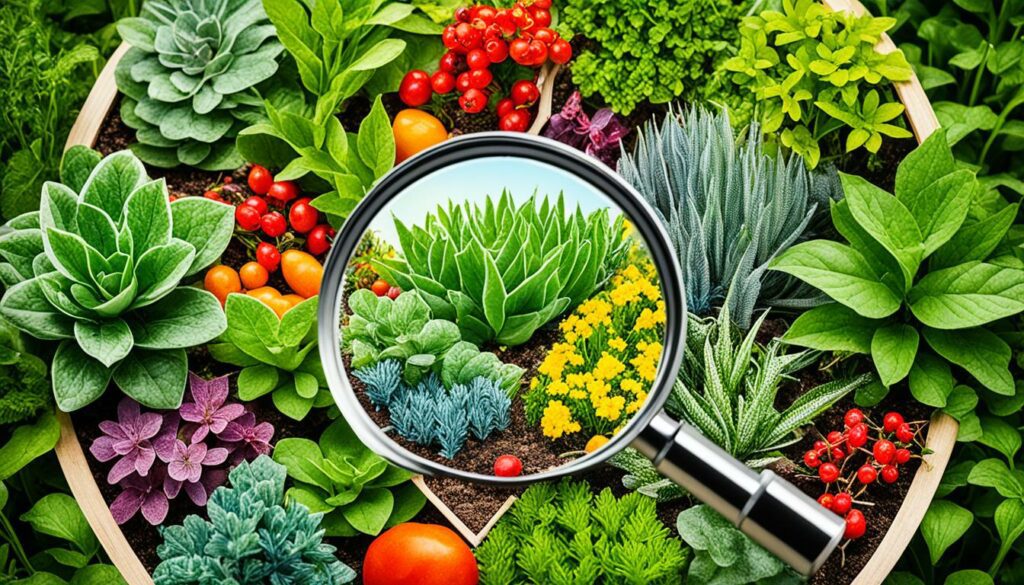
In farming, we often use Bacillus and Actinobacteria to beat soil diseases. For example, Pseudomonas aeruginosa and Bacillus subtilis work well against root and stem diseases. We apply these agents by adding them to the soil or seeds. This way, they get right to work where the plants need them most.
| Biocontrol Agent | Target Pathogen | Mode of Application | Host Plant |
|---|---|---|---|
| Trichoderma harzianum CECT 2413 | Root rot | Soil inoculation | Pepper |
| Pseudomonas aeruginosa MBAA1 | Stem rot | Seed bacterization | Soybean |
| Bacillus subtilis GBO3 | Root rot | Seed application | Dry bean |
Using biocontrol agents really boosts soil health. They increase the variety of microbes in the soil, making it stronger. In China, studies in tobacco fields have shown this. They found that fields with more microbial friends got sick less. So, having good germs around helps protect the soil from bad ones.
Crop rotation is a proven farming technique. It helps improve soil health and control pests. Farmers achieve this by changing the crops they plant in a specific order. This breaks the cycle of pests and diseases, making them less of a problem. For example, in peanut fields, disease numbers rose sharply when not rotated. Meanwhile, in fields that rotated crops, the disease increase was lower.
There are many good things about crop rotation. Firstly, it lowers disease risks. If the same crop is grown in the same field for years, diseases can spread fast. For example, peanut fields can get a serious disease if not rotated.
Secondly, crop rotation is good for the tiny life in the soil. Studies show that by changing crops, the soil’s ability to fight diseases gets better. For instance, growing wheat and soybeans one after the other helps boost the soil’s health by attracting good microbes.
| System | 2012 DI | 2016 DI |
|---|---|---|
| Monocropping | 2.1 | 8.0 |
| Rotation | 1.6 | 3.1 |
Choosing the right crops for rotation is very important. Many crops like soybeans do better in rotation. They grow best when fields are rotated every three years. In a place in northeastern China, new and effective rotation plans have been developed.
When selecting crops, it’s also key to think about the soil’s health. Mixing legumes, cereals, and cover crops boosts the soil’s nutrients. This helps the land stay fertile and healthy. Plus, it helps create a richer environment for plants to grow in.
In a city in China, a project showed how much better crop rotation can make the land. Over five years, different rotations improved the soil and led to more crops. This shows the importance of picking the right crops for rotation.
Conservation tillage is crucial in farming for many reasons. It helps keep farming sustainable and strong. This method works by disturbing the soil less. This makes the soil better at holding water. It also means less soil is washed away. This helps keep the topsoil, which is important for future crops.
Many kinds of tillage and straw keeping methods have been studied. These include methods like no-tillage no-straw keeping, keeping straw under no-tillage, and more. Some studies show that while tillage doesn’t affect certain soil aspects, straw keeping does. It changes soil’s nitrogen, phosphorus, and potassium levels. This shows how important conservation tillage is for how soil uses nutrients.
Keeping straw affects the kinds of microbes in the soil too. Even though the number of types decreases, the variety within these types goes up. This means the different microbes start working more together in the soil. They form a stronger community. This is good for the soil’s health.
No-tillage is a type of conservation tillage that’s great for soil. It mixes in more organic material, making the soil richer. It also boosts the soil’s life, lowers the chances of it being washed away, and doesn’t cost as much. By not tilling the soil, farmers save on work and money. They also keep the soil’s nutrients and structure better. This is because when you don’t touch the soil too much, it stays healthier.
There’s a deep link between how we till the soil and which microbes live in it. How these microbes grow can follow rules, be random, or change based on how we till and keep the straw. Conservation tillage can influence the amounts and kinds of these microbial communities. For instance, keeping straw boosts some types of bacteria but lowers others. This makes a big difference in the soil’s life.
Using conservation tillage is a smart choice for farmers. It leads to better use of nutrients and keeps the soil firmer. Strategies like straw keeping and managing crop leftovers well are key. They bring good things for the environment and the farm’s finances. This way, farming gets better and more future-proof.
| Tillage Practice | Stochastic Processes | Nutrient Dynamics |
|---|---|---|
| CntWt | Moderate | Stable |
| CntWntS | Low | Enhanced |
| CntWtS | High | Stable |
| CntWnt | Very High | Variable |
Cover crops are essential for keeping our soils healthy. They are mainly grown to cover the soil. This is more important than using the plants for food. As our world’s population grows – reaching 9.8 billion by 2050 – we need more food. The use of cover crops is key to keeping the soil healthy and productive. They help keep nutrients in the soil, make the soil structure better, and support tiny life forms.
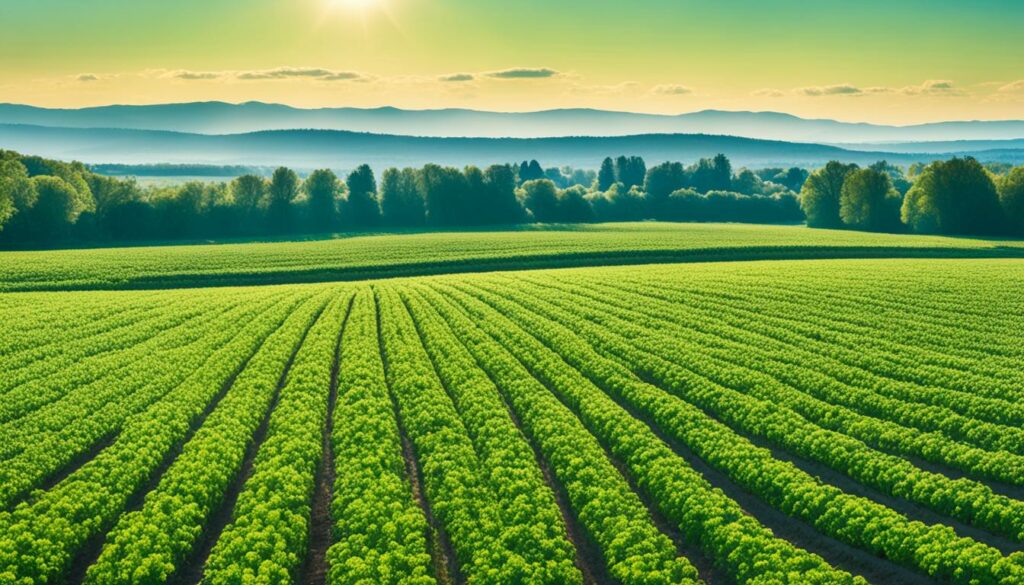
Cover crops stop the soil from washing or blowing away. They protect against the hard-hitting force of rain and wind. This helps keep the soil where it belongs. Cover crops also help clean the water that soaks into the soil. This is good for plant growth. Plus, they can fight off the bad bugs in the soil, making it a healthier place.
They’re also great at making the soil full of natural materials like carbon and nitrogen. Different cover crops add special things to the soil. This helps the tiny creatures living in the soil thrive. Cover crop roots give off substances like sugars. These substances feed the good life in the soil.
There are many types of cover crops for different places and soils:
Each type brings its own benefits. For example, legumes help make soil rich by capturing nitrogen. Brassicas are good at keeping the soil free from bad bugs.
| Cover Crop | Primary Benefits | Best Use Conditions |
|---|---|---|
| Grasses (e.g., Rye) | Weed suppression, improved soil structure | Versatile, suitable for most climates |
| Legumes (e.g., Clover) | Nitrogen fixation, improved soil fertility | Temperate regions with moderate rainfall |
| Brassicas (e.g., Mustard) | Pathogen suppression, biofumigation | Cool climates, well-drained soils |
Farmers can choose the right cover crops to make their soil better. This boosts food production and helps us meet the need for more food. Using cover crops means less ploughing. It also cuts the use of chemicals. This leads to healthier and stronger soil for the future.
It’s vital to get why organic matter is key to soil health. With the world’s population due to hit 9.7 billion by 2050, we need to up our food game by 70%. Organic matter helps soil stay healthy, full of nutrients, and ready to hold onto water. These are must-haves for soil that’s great at growing food.
Where does this organic matter come from? Mostly from leftovers of plants and animals, like compost, manure, and old plants. These things break down and become nutrients for the soil. Cover crops and changing what we plant each season also help. They keep adding to the soil and stop it from washing away.
Plants like chickpeas and white lupines are superstars for the soil. They unlock and bring more phosphorus, an important nutrient. Mixing up which crops we grow (crop rotation) is a key part of keeping soil healthy. It helps move nutrients around and keeps pests in check.
Organic matter gets the soil buzzing with life. Tiny creatures, like helpful bacteria, love to eat up the organic leftovers. This breakdown not only cleans up the soil but also helps plants get the nutrients they need. A 2007 study and a 2003 publication highlighted how important these little guys are for a healthy ecosystem.
Making the soil full of organic matter also does good for the planet by locking away carbon. This is a big help in our fight against global warming. Plus, a thriving microbial community means we can farm sustainably for a long time without as many chemicals.
So, never forget how crucial organic matter is. It’s all about making the soil a happy place for good microbes, lots of nutrients, and great crops.
| Aspect | Impact |
|---|---|
| Water Retention | Improves soil’s capacity to retain moisture, reducing irrigation needs. |
| Nutrient Availability | Increases nutrient content and availability for plants, enhancing growth. |
| Microbial Activity | Boosts the diversity and function of soil microorganisms, essential for nutrient cycling. |
| Soil Structure | Improves soil texture and structure, reducing erosion and compaction. |
Modern farming heavily relies on agrochemicals, affecting the tiny world of soil microbes. These chemicals influence soil health and its tiny inhabitants. Thus, controlling the use of agrochemicals is crucial.
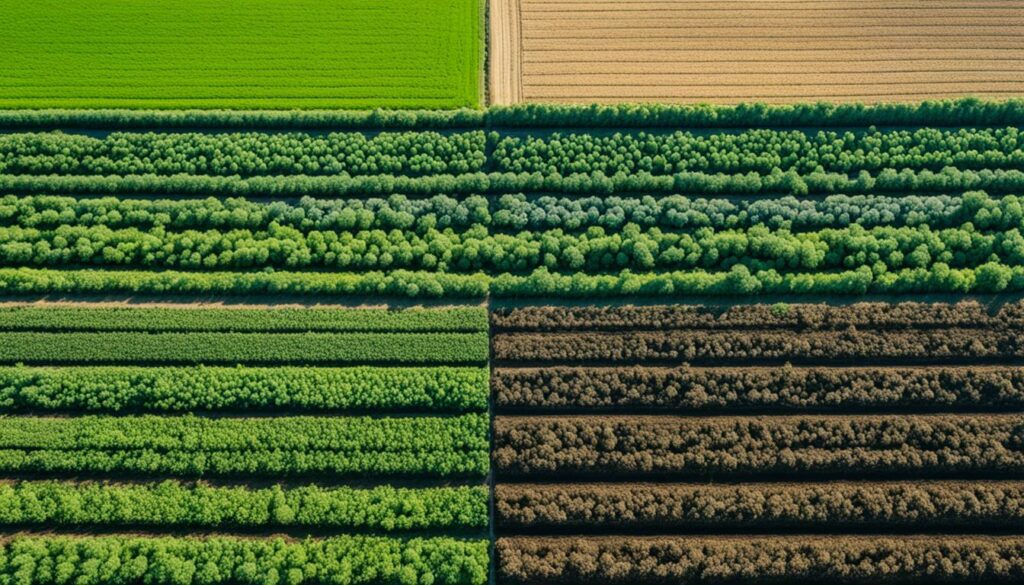
Studies have found that agrochemicals can harm the soil’s good bacteria. They also lower the diversity of these helpful organisms, damaging both the nutrient processes and soil quality. For example, nitrogen fertilizers can throw off the balance of these microbes. Continuous nitrogen use can also hurt the bacteria around plant roots over time.
All of this throws off the delicate structure of the soil’s microbiome. So, it’s clear that using pesticides the wrong way can make things worse.
To keep the soil microbiome healthy, it’s vital to manage agrochemicals wisely. Integrated pest management (IPM), timing and dosing chemicals well, and using biological solutions are key. A 2014 study suggested that these methods offer significant benefits for the soil ecosystem.
By combining various strategies, we can lessen our reliance on agrochemicals. This helps keep the soil’s microorganisms diverse and supports sustainable farming.
| Country | Pesticide Consumption (Tons) | Main Concerns |
|---|---|---|
| China | 1.8 Million | High toxicity levels |
| United States | 0.4 Million | Regulatory challenges |
| Brazil | 0.5 Million | Presence of banned substances, residues in food |
The world’s food system is under a lot of stress. Why? Well, because the global population is set to hit 9.7 billion by 2050. This means we’ll need to produce 70% more food. To meet this demand, we must find ways to farm that are good for the Earth. This way, we avoid using up our natural resources and hurting the planet. It’s crucial we adopt farming techniques that keep the soil and environment healthy for years to come.
Farming sustainably means using methods that look after the soil. Techniques like agroforestry, intercropping, and conservation tillage are key. Agroforestry mixes trees with crops and animals. This boosts biodiversity and offers benefits like natural shade and better growing conditions. Intercropping is about planting different crops together. This can help decrease pest attacks and make the most of the land.
Conservation tillage is a method that doesn’t disturb the soil much. It helps keep the soil healthy and stops it from washing away. Adding organic fertilizers like compost or manure enriches the soil. It feeds the little life in the soil, making it more alive and diverse. These practices make farms stronger against the challenges of weather and help make sure there is enough food.
Sustainable farming methods bring big advantages for the soil over time. A healthy soil is full of organic material, has lots of helpful microbes, and cycles nutrients well. For instance, planting crops like chickpeas can make phosphorus in the soil more available. This is good for plants and helps the soil’s microorganisms thrive. Using crop rotation is another essential method. It’s great for fighting off pests, keeping the soil rich, and making sure plants get what they need.
A strong soil life is not just good for crops. It also helps clean the soil and makes its own nutrients. By farming the right way, we keep the planet healthy. This means we can keep producing food without hurting the Earth. And that is important for us and for the generations to come.
With our global population set to reach 9.7 billion by 2050, the need for sustainable agriculture is clear. It’s crucial that we recognise the essential role of the soil microbiome. This tiny world is key in recycling nutrients, controlling pests, and keeping the ecosystem healthy.
Studies in Mol. Ecol. (2018) and Nature (2017) show soil microorganisms are diverse and strong. They are vital for the success of farming that’s kind to the Earth.
Methods like changing crops each season, using ground covers, and adding organic matter make soil richer. They also help the microorganisms thrive. Plants like chickpeas and white lupine are great for helping soil and using nutrients efficiently.
Adding beneficial bugs and fertilizers that come from nature makes the soil even healthier. This supports farming that cares for the land, which is important for growing food sustainably.
To keep soil microorganisms happy and working well, we should use less harmful chemicals. We should manage water carefully too. This combined way of working helps farms bounce back from tough times.
By using these methods, we look after our land better. This means we can keep farming in a way that’s good for the Earth. It ensures we have enough food for the future.
The soil microbiome is a complex community of microorganisms found in a defined area. These include friendly, mutual, and harmful types. They help in agriculture by preventing diseases, spurring growth, and aiding in nutrient intake by plants.
Soil microbes play a big part in recycling nutrients and keeping the environment running well. They are key for healthier plants, better nutrient use, and fighting off harmful diseases. This makes them very important for farming that’s good for the earth and us.
Having many different microbes in the soil makes everything work better. This supports plant health and fights off different stresses. Soils full of diverse bacteria can help grow food and offer many benefits to the environment.
Certain bacteria are vital for soil’s good health. They help fix nitrogen and make essential nutrients like phosphorus available. Plus, they fight off bad bacteria, keeping the soil fertile and productive.
Soil bacteria are heroes for plant growth. They fix nitrogen, make key nutrients available, and combat dangerous microbes. All this keeps the soil well and supports growing food in a sustainable way.
Soil fungi break down dead matter, recycle nutrients, and help plants absorb water and nutrients. This vital role keeps the soil healthy and aids plant growth.
To help fungi, we can make soil conditions just right, add natural materials, and farm in eco-friendly ways. Doing this boosts helpful fungal life in the soil.
In the soil, different microorganisms often work together in good ways. These include making food crops richer in nutrients and supporting farming that’s kind to the planet.
Soil microbial ecology studies how different tiny life forms interact with their surroundings. It looks at these interactions’ effects on the soil’s health, nutrient movement, and the environment in general.
The mix of microbes in the soil plays a key role in how well plants grow and fight off stress. Knowing about this mix is vital for keeping soils healthy for growing crops.
Boosting microbe action in the soil is all about using natural methods and farming in ways that disturb the soil less. These steps maintain a rich soil ecosystem, crucial for growing food in a sustainable manner.
Healthy soil life brings many good things, like better plant growth, efficient nutrient use, and lower risks from bad organisms. It’s a key factor in achieving a balance that supports great crops and a healthy environment.
There are biofertilisers that add nutrients through fixing nitrogen and unlocking phosphorus. They meet different crop needs and can be used in various ways.
By working in harmony with plants and naturally enriching the soil, biofertilisers keep our farms safe, lively, and long-lasting. They contribute to a healthy cycle of plant growth and soil renewal.
Biocontrol agents are living things like bacteria and fungi that control pests and diseases without harmful chemicals. They protect and enhance the health of our vital farming land.
Rotating crops improves soil and helps keep pests at bay. Changing what’s grown helps create a rich and balanced soil environment. This leads to more fertile soil and better crop production.
Conservation tillage stops soil from washing away and keeps it full of life by disturbing it less. This improves the way soil holds water, trades nutrients, and supports growing good food.
Cover crops shield the soil, shape it better, boost helpful microbe life, and stop weeds. While picking the right cover crop depends on the place and the crops, their use is a smart move for healthy soil.
Organic matter makes soil more fertile and helps hold water and nutrients. It comes from natural sources like plant waste and manure, which feed soil life and keep it rich.
Agrochemicals can harm the soil microbiome by reducing its variety of life. This diversity is key for a strong soil ecosystem. Careful use of chemicals, alongside smart pest management, can lessen the harm.
Sustainable farming uses trees among crops, mixes plant types, protects the ground, and feeds the soil naturally. These methods promote a living and balanced earth, ideal for growing food long-term.